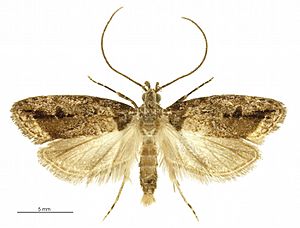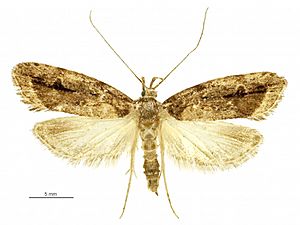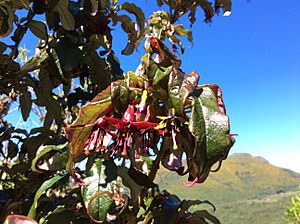Izatha caustopa facts for kids
Quick facts for kids Izatha caustopa |
|
|---|---|
 |
|
| Male | |
 |
|
| Female | |
| Scientific classification | |
| Kingdom: | |
| Phylum: | |
| Class: | |
| Order: | |
| Family: |
Oecophoridae
|
| Genus: | |
| Species: |
I. caustopa
|
| Binomial name | |
| Izatha caustopa (Meyrick, 1892)
|
|
| Synonyms | |
|
|
Izatha caustopa is a special kind of moth found only in New Zealand. It's often called a lichen tuft moth. This moth is part of the Oecophoridae family. It's quite rare and has only been seen a few times in the southern part of the North Island. In fact, before 2016, no one had seen this moth for 30 years! Because it's so hard to find, the Department of Conservation says we don't have enough information about it.
Contents
Discovering the Izatha caustopa Moth
This moth was first described in 1892 by a scientist named Edward Meyrick. He used a female moth collected by another scientist, George Hudson, in Wellington. Mr. Hudson later wrote about and drew pictures of this moth in his 1928 book, The Butterflies and Moths of New Zealand. The original moth specimen, which is very important for identifying the species, is kept at the Natural History Museum, London.
What Does Izatha caustopa Look Like?
This moth is fairly large for its group. Male moths have a wingspan (the distance from one wingtip to the other) of about 24 to 26 millimeters. Female moths are a bit bigger, with a wingspan of 29 to 31.5 millimeters.
Their heads are a mix of light brown and whitish colors. Their bodies are dark brown with some whitish parts. The legs are dark brown with whitish rings.
The front wings are long and narrow. They are mostly whitish-brown with darker brown and blackish spots. There's a dark patch near the base of the wing. There's also a large, dark, trapezoid-shaped blotch in the middle. A cloudy black line runs from the middle of the wing towards the tip. The back wings are whitish-brown.
Where Does Izatha caustopa Live?
This moth is found only in New Zealand. Even there, it's known from only a few specific places. It has been seen in the Taupo, Hawkes Bay, and Wellington areas.
In the past, George Hudson found this moth in small groups of kōtukutuku trees in places like Gollans Valley and Wilton's Bush, near Wellington. He collected his last specimen in 1942. A single moth was found in Ohakune in 1921. Two more were found near Napier in 1964 and 1985.
After 30 years of no sightings, two I. caustopa moths were found again in 2016. They were discovered at Bushy Park, which is near Whanganui.
Life Cycle and Food
The larvae (caterpillars) of this moth grow inside the dead branches of a tree called kōtukutuku (Fuchsia excorticata). They feed during the winter months, digging tunnels through the soft wood. Like most lichen tuft moths, they probably eat fungi that grow on the wood.
The larvae are fully grown by about October. The adult moths are usually seen flying in January and February. There have also been a few sightings in December and April.
Why Is Izatha caustopa So Rare?
This moth is listed as "Data Deficient" by the New Zealand Threat Classification System. This means scientists don't have enough information to know if it's truly endangered or not.
One reason for its rarity might be the decline of its host tree, the kōtukutuku. This tree is a favorite food for possums, which are not native to New Zealand.
It's also possible that the moth is more common than we think. It might just be hard to find because it's not attracted to bright lights, unlike many other moths. The moths found at Bushy Park were caught in a special trap called a Malaise trap, which helps scientists catch insects without using light.
Images for kids




